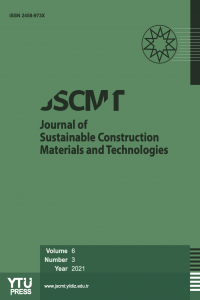Study of thermal and mechanical properties of typha leaf - clay panels
Study of thermal and mechanical properties of typha leaf - clay panels
Clay, mechanical strength, thermal conductivity, thermal effusivity, typha,
___
- [1] Meukam, P., Jannot, Y., Noumowe, A., & Kofane, T. (2004). Thermo physical characteristics of econom- ical building materials. Construction and Building Materials, 18(6), 437–443. [CrossRef]
- [2] Millogo, Y., Morel, J. C., Aubert, J. E., & Ghavami, K. (2014). Experimental analysis of Pressed Adobe Blocks reinforced with Hibiscus cannabinus fibers. Construction and Building Materials, 52, 71–78. [CrossRef ]
- [3] Bal, H., Jannot, Y., Quenette, N., Chenu, A., & Gaye, S. (2012). Water content dependence of the porosity, density and thermal capacity of laterite based bricks with millet waste additive. Construction and Build- ing Materials, 31, 144–150. [CrossRef]
- [4] Tettey, U. Y. A., Dodoo, A., & Gustavsson, L. (2014). Effects of different insulation materials on primary energy and CO2 emission of a multi-storey resi- dential building. Energy and Buildings, 82, 369–377. [CrossRef ]
- [5] de Bruijn, P. B., Jeppsson, K. H., Sandin, K., & Nils- son, C. (2009). Mechanical properties of lime–hemp concrete containing shives and fibres. Biosystems Engineering, 103(4), 474–479. [CrossRef]
- [6] Ashori, A., & Nourbakhsh, A. (2008). Effect of press cycle time and resin content on physical and me- chanical properties of particleboard panels made from the underutilized low-quality raw materi- als. Industrial Crops and Products, 28(2), 225–230. [CrossRef ]
- [7] Lertsutthiwong, P., Khunthon, S., Siralertmukul, K., Noomun, K., & Chandrkrachang, S. (2008). New insulating particleboards prepared from mixture of solid wastes from tissue paper manufacturing and corn peel. Bioresource Technology, 99(11), 4841– 4845. [CrossRef ]
- [8] Cuk, N., Kunaver, M., & Medved, S. (2011). Prop- erties of particleboards made by using an adhesive with added liquefied wood. Materiali in Tehnologije, 45(3), 241–245.
- [9] Cérézo, V. (2005). Propriétés mécaniques, ther- miques et acoustiques d’un matériau à base de part- icules végétales: approche expérimentale et modélisation théorique [Doctoral dissertation, Institut National des Sciences Appliquées, Lyon. (French)
- [10] Chikhi, M., Agoudjil, B., Boudenne, A., & Gher- abli, A. (2013). Experimental investigation of new biocomposite with low cost for thermal insulation.Energy and Buildings, 66, 267–273. [CrossRef]
- [11] Awwad, E., Choueiter, D., & Khatib, H. (2013). Concrete masonry blocks reinforced with local in- dustrial hemp fibers and hurds. Proceedings 3rd In- ternational Conference On Sustainable Construction Materials And Technology, Kyoto, Japan, 28, 18–21.
- [12] Chinta, S. K., Katkar, P. M., Jafer, M. M. (2013). Nat- ural fibres reinforced gypsum composites. International Journal of Engineering and Management Sciences, 4(3), 318–325.
- [13] Moussa, T., Maalouf, C., Lachi, M., Umurigirwa, S., Mai, T. H., & Henry, J. F. (2016). Development and performance evaluation of a hemp–starch com- posite. Journal of Building Physics, 40(3), 278–295. [CrossRef ]
- [14] Ponnukrishnan, P., Thanu, M. C., & Richard, S. (2014). Mechanical characterization of Typha Domingensis natural fiber reinforced polyester com- posites. International Journal of Research Science and Technology Engineering Mathematics, 6, 241-244.
- [15] Diatta, M. T., Gaye, S., Thiam, A., & Azilinon, D. (2011). Détermination des propriétés thermo-phy- sique et mécanique du typha australis. In Congres SFT, Perpignan, (France).
- [16] Dieye, Y., Sambou, V., Faye, M., Thiam, A., Adj, M., & Azilinon, D. (2017). Thermo-mechanical char- acterization of a building material based on Typha Australis. Journal of Building Engineering, 9, 142– 146. [CrossRef ]
- [17] Niang, I., Maalouf, C., Moussa, T., Bliard, C., Samin, E., Thomachot-Schneider, C., Lachi, M., Pron, H., Mai, T. H., & Gaye, S. (2018). Hygrothermal perfor- mance of various Typha–clay composite. Journal of Building Physics, 42(3), 316–335. [CrossRef]
- [18] Maillet, D., André, S., Batsale, J. C., Degiovanni, A., & Moyne, C. (2000). Solving the Heat Equation through Integral Transforms. Wiley.
- [19] Collet, F., & Pretot, S. (2014). Thermal conductivity of hemp concretes: Variation with formulation, den- sity and water content. Construction and Building Materials, 65, 612–619. [CrossRef]
- [20] Collet-Foucault, F. (2004). Caractérisation hydrique et thermique de matériaux de génie civil à faibles impacts environnementaux [Doctoral Dissertation, Rennes, INSA].
- [21] Evrard, A. (2008). Transient hygrothermal behaviour of lime-hemp materials [Doctoral Dissertation, Uni- versité catholique de Louvain].
- Başlangıç: 2016
- Yayıncı: Yıldız Teknik Üniversitesi
Assessing the potentials of low impact materials for low energy housing provision in Nigeria
Oluwafemi AKANDE, Shadrach AKOR, Basil FRANCIS, Solomon ODEKINA, Emmanuel EYIGEGE, Mubarak ABDULSALAM
Study of thermal and mechanical properties of typha leaf - clay panels
Younouss DIEYE, Pape M. TOURE, Seckou BODIAN, Prince M. GUEYE, Mactar FAYE, Vincent SAMBOU
Saliha BOUDIA, Farida FERNANE, Patrick SHARROCK, Marina FIALLO
Evaluation of Concrete Pavers Affected by Manavgat Wildfires
